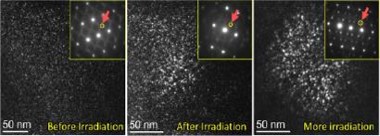
RaDIATE International Collaboration
J-PARC Center
High Energy Accelerator Research Organization (KEK)
Japan Atomic Energy Agency (JAEA)
Fermi National Accelerator Laboratory (FNAL)
Pacific Northwest National Laboratory (PNNL)
Brookhaven National Laboratory (BNL)
Science and Technology Facilities Council (STFC) Rutherford Appleton Laboratory (RAL)
Highlights of the Achievement
●A high-strength titanium alloy Ti-6Al-4V is widely employed as the “beam window” at high-intensity
proton accelerator facilities, such as FNAL and J-PARC. However, this alloy suffers from radiation-
induced hardening and loss of ductility after proton beam exposure. It is urgent to clarify the source of
this degradation in mechanical properties to achieve stable high-intensity beam operations at these
facilities, aiming to validate leptonic CP-violation by conducting long-baseline neutrino oscillation
experiments.
●An international collaboration conducted high-intensity proton beam exposure on various accelerator
target and beam window materials, followed by post-irradiation examinations with state-of-the-art
analytical equipment. As a result, it has been clarified that in Ti-6Al-4V, a high density of nanoscale
defect clusters in the primary alpha Ti phase lead to extreme hardening and loss of ductility, further
exacerbated by the evolution of a high density of small “omega phase” particles in the beta phase. These
observations suggest that defects in the alpha phase are most likely responsible for the observed
radiation hardening, as demonstrated in other metallic systems after moderately low irradiation
temperature proton or neutron irradiation. The formation and growth of radiation-induced high-
density omega phase precipitates, first observed in this study in proton-irradiated Ti-base alloys, is
worthy of further investigation to clarify their role in mechanical property degradation.
●Understanding the sources of radiation hardening in Ti-6Al-4V and other alloys will guide the final
choice of alloy grade and proper heat-treatment method to allow for the next-generation beam window
to withstand the high-intensity proton beam operation. It may also be beneficial for the development
of new radiation damage-tolerant materials for fusion reactors and accelerator-driven nuclear
transmutation systems.
Please refer to the press release for details.
